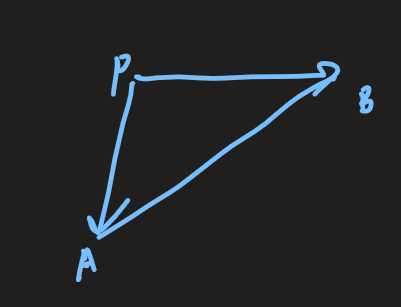题意:给出一个箱子的左上角和右下角的坐标,可以插入一些板子,每块板子的上顶点和下顶点。然后给定一堆玩具,扔到箱子里,求每个分隔区域里面的玩具数量。
分析:因为板子的坐标是按顺序从小到大给出的,我们的一个点,如果在一个板子的左边,那么就在这块板子后面的板子的坐标,但是在左侧板子的右边,具有单调性,可以用二分。判断一个点是否在一个直线的左右侧的时候,我们可以使用叉乘。

如果\(\vec{pa} \times \vec{pb}\) < 0,表示\(p\)点在\(AB\)的左侧,如果>0,表示在\(AB\)的右侧,== 0则表示在\(AB\)的线上。
\(时间复杂度o(mlogn),n表示板子的数量,m表示玩具,logn表示对n块板子的位置二分。\)
#include <iostream>
#include <cstdio>
#include <cstring>
#include <vector>
#include <cmath>
#include <algorithm>
using namespace std;
const double eps = 1e-10;
const double PI = acos(-1.0);
struct Point
{
double x, y;
Point(double x = 0, double y = 0) :x(x), y(y) {}
void operator=(const Point& rhs)
{
this->x = rhs.x;
this->y = rhs.y;
}
};
typedef Point Vector;
//向量 + 向量 = 向量, 点 + 向量 = 点
Vector operator + (Vector A, Vector B) { return Vector(A.x + B.x, A.y + B.y); }
//点 - 点 = 向量
Vector operator - (Point A, Point B) { return Vector(A.x - B.x, A.y - B.y); }
//向量 * 标量 = 向量
Vector operator * (Vector A, double p) { return Vector(A.x * p, A.y * p); }
//向量 / 数 = 向量
Vector operator / (Vector A, double p) { return Vector(A.x / p, A.y / p); }
int dcmp(double x)
{
if (fabs(x) < eps) return 0;
else return x < 0 ? -1 : 1;
}
bool operator<(const Point& a, const Point& b)
{
return dcmp(a.x - b.x) < 0 || dcmp(a.x - b.x) == 0 && dcmp(a.y - b.y) < 0;
}
bool operator == (const Point& a, const Point& b)
{
return dcmp(a.x - b.x) == 0 && dcmp(a.y - b.y) == 0;
}
//求叉积
double Cross(Vector A, Vector B) { return A.x * B.y - A.y * B.x; }
double Dot(Vector A, Vector B) { return A.x * B.x + A.y * B.y; }
double Length(Vector A) { return sqrt(Dot(A, A)); }
Vector Normal(Vector A)
{
double L = Length(A);
return Vector(-A.y / L, A.x / L);
}
struct Line {
Point p;
Vector v;
Line() {};
Line(Point p, Vector v) :p(p), v(v) { }
//直线上的点坐标
Point point(double t) {
return p + v * t;
}
//平移直线d距离
Line move(double d) {
return Line(p + Normal(v) * d, v);
}
};
const int N = 5050;
Line lines[N];
int cnt[N];
bool check(Point q, int mid)
{
//直线两端的点
Point a = lines[mid].point(1);
Point b = lines[mid].point(0);
Vector qa(a - q);
Vector qb(b - q);
if (dcmp(Cross(qa, qb)) < 0) return true;
return false;
}
void init()
{
memset(lines, 0, sizeof lines);
memset(cnt, 0, sizeof cnt);
}
int main()
{
int n, m;
double x1, y1, x2, y2;
while (scanf("%d", &n) != EOF)
{
if (n == 0) break;
scanf("%d%lf%lf%lf%lf", &m, &x1, &y1, &x2, &y2);
lines[0].p = Point(0, y2);
lines[0].v = Point(x1, y1 - y2);
//每个隔板的直线
double t, b;
for (int i = 1; i <= n; ++i)
{
scanf("%lf%lf", &t, &b);
lines[i].p = Point(b, y2);
lines[i].v = Point(t - b, y1 - y2);
}
lines[n + 1].p = Point(x2, y2);
lines[n + 1].v = Point(0, y1 - y2);
double toyx, toyy;
//m个玩具
for (int i = 1; i <= m; ++i)
{
scanf("%lf%lf", &toyx, &toyy);
Point toy(toyx, toyy);
//二分在哪个板子左侧
int l = 0, r = n + 1;
while (l < r)
{
int mid = l + r >> 1;
if (check(toy, mid)) r = mid;
else l = mid + 1;
}
++cnt[l - 1];
}
for (int i = 0; i <= n; ++i)
{
printf("%d: %d\n", i, cnt[i]);
}
puts("");
init();
}
return 0;
}
POJ-2318 TOYS(二分)(叉乘)(判断点在直线的哪侧)
原文:https://www.cnblogs.com/pixel-Teee/p/13276889.html